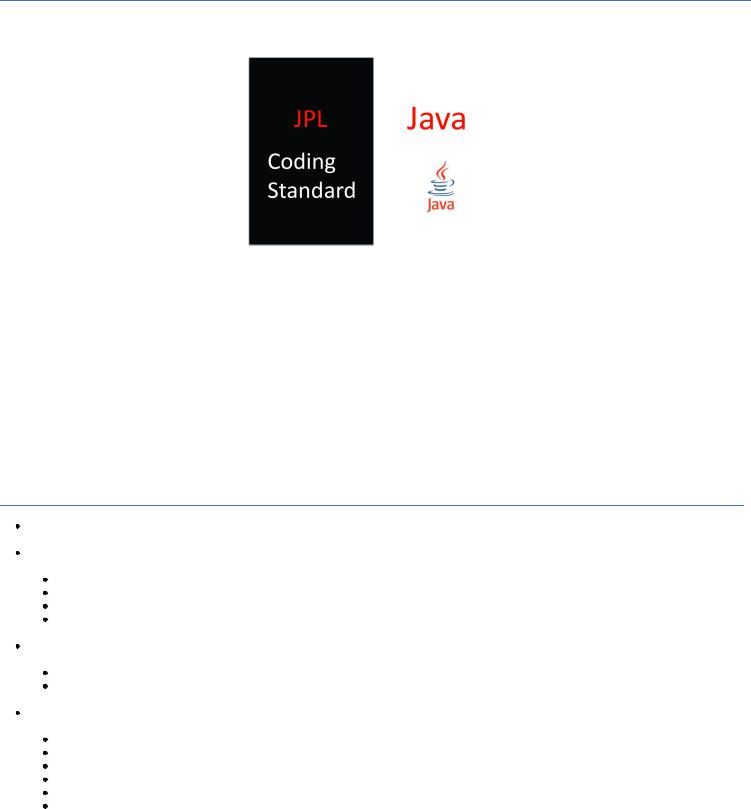
JPL_Coding_Standard_Java
.pdf
Java Coding Standard - Confluence |
1/25/10 1:40 PM |
 JPL Java Coding Standard
JPL Java Coding Standard
Java Coding Standard
Added by Klaus Havelund, last edited by Klaus Havelund on Jan 25, 2010 (view change)
Labels: ADD LABELS
JPL Institutional Coding Standard for the Java Programming Language
Jet Propulsion Laboratory
(c) 2009 California Institute of Technology. Government sponsorship acknowledged.
The research described in this document was carried out at the Jet Propulsion Laboratory, California Institute of Technology, under a contract with the National Aeronautics and Space Administration.
Version: 1.1
Date: January 25, 2010
Table of Contents
introduction
process
R01 compile with checks turned on
R02 apply static analysis
R03 document public elements
R04 write unit tests
names
R05 use the standard naming conventions
R06 do not override field or class names
packages, classes and interfaces
R07 make imports explicit
R08 do not have cyclic package and class dependencies
R09 obey the contract for equals()
R10 define both equals() and hashCode()
R11 define equals when adding fields
R12 define equals with parameter type Object
https://jplwiki.jpl.nasa.gov:8443/pages/viewpage.action?spaceKey=javastd&title=Java+Coding+Standard&decorator=printable |
Page 1 of 40 |

Java Coding Standard - Confluence |
1/25/10 1:40 PM |
R13 do not use finalizers
R14 do not implement the Cloneable interface
R15 do not call nonfinal methods in constructors R16 select composition over inheritance
fields
R17 make fields private
R18 do not use static mutable fields
R19 declare immutable fields final
R20 initialize fields before use
methods
R21 use assertions
R22 use annotations
R23 restrict method overloading
R24 do not assign to parameters
R25 do not return null arrays or collections
R26 do not call System.exit
declarations and statements
R27 have one concept per line
R28 use braces in control structures
R29 do not have empty blocks
R30 use breaks in switch statements
R31 end switch statements with default
R32 terminate if-else-if with else
expressions
R33 restrict side effects in expressions
R34 use named constants for non-trivial literals
R35 make operator precedence explicit
R36 do not use reference equality
R37 use only short-circuit logic operators
R38 do not use octal values
R39 do not use floating point equality
R40 use one result type in conditional expressions
R41 do not use string concatenation operator in loops
exceptions
R42 do not drop exceptions
R43 do not abruptly exit a finally block
types
R44 use generics
R45 use interfaces as types when available
R46 use primitive types
R47 do not remove literals from collections
R48 restrict numeric conversions
concurrency
R49 program against data races
R50 program against deadlocks
R51 do not rely on the scheduler for synchronization
R52 wait and notify safely
complexity
R53 reduce code complexity
references
https://jplwiki.jpl.nasa.gov:8443/pages/viewpage.action?spaceKey=javastd&title=Java+Coding+Standard&decorator=printable |
Page 2 of 40 |

Java Coding Standard - Confluence |
1/25/10 1:40 PM |
introduction
This document presents first version of a JPL institutional coding standard for the Java programming language. The primary purpose of the standard is to help Java programmers reduce the probability of run-time errors in their programs. A secondary, but related, purpose is to improve on dimensions such as readability and maintainability of code.
The standard is meant for ground software programming. The restrictions on ground software are less severe than the restrictions on flight software, mainly due to the richer resources available on ground software computers, and the often less time critical nature of ground applications. However, note that JPL ground software indeed can be mission critical (meaning that a loss of capability may lead to reduction in mission effectiveness). Amongst the most important general differences from the JPL institutional C coding standard for flight software references (JPL-C-STD) are: (1) the Java standard allows dynamic memory allocation (object creation) after initialization, (2) the Java standard allows recursion, and (3) does not require loop bounds to be statically verifiable. Apart from these differences most other differences are due to the different nature of the two languages.
The coding standard consists of 53 rules expressing mostly what programming patterns to avoid. The standard, however, also mentions a few rules concerned with process, including recommendations to use static analysis, document and unit test code. Rules are not prioritized, and should generally be considered as guidelines. Every rule has exceptions and should not be followed to the extreme.
The rules are formulated on the basis of studies of various resources, including websites, other (often very informal) standards, books, and static analyzers. Many rules have counterparts in one or more of these resources. The references at the end of the document lists all resources used to produce this standard. In addition, relevant resources are mentioned along each rule.
A set of rules such as those presented in this standard can appear arbitrary. They are indeed ultimately a result of personal judgment. An optimal solution would be a universal Java coding standard accepted by the general Java community. Unfortunately such a standard does not currently exist. Perhaps the most important message is that JPL programmers should use state-of-the-art static analyzers to check their code (rule R2). Such analyzers will likely check many of those rules that the Java community agrees on. This document recommends a set of such analyzers.
A rule checker implementing the rules in this standard is currently being developed using the Semmle static analyzer http://semmle.com .
.
The rules are numbered, and are divided onto groups reflecting constructs of the Java programming language. A group is named in Blue. Each rule within a group is named in Red. Each rule is described in a framed box:
You should follow this standard.
optionally followed by an elaboration (further explanation of the rule), a rationale, exceptions to the rule, examples, comments, and references to resources that have influenced the formulation of the rule.
User comments
User comments are encouraged and can be added at the end of the document or sent by email to: klaus.havelund@jpl.nasa.gov.
People contributing to this standard
The standard is being developed by:
Klaus Havelund (klaus.havelund@jpl.nasa.gov)
Al Niessner (al.niessner@jpl.nasa.gov)
The following additional people at JPL have contributed to the standard via their comments:
Eddie Benowitz
Thomas Crockett
Bob Deen
Dan Dvorak
Gerard Holzmann
Thomas Huang
Rajeev Joshi
David Wagner
process
https://jplwiki.jpl.nasa.gov:8443/pages/viewpage.action?spaceKey=javastd&title=Java+Coding+Standard&decorator=printable |
Page 3 of 40 |

Java Coding Standard - Confluence |
1/25/10 1:40 PM |
R01. compile with checks turned on
All code should be compiled with all warnings and error checking turned on, with no errors or warnings resulting.
Elaboration
The default operation for some compilers, like gcc, is to not expose all the warnings it finds while parsing and compiling the input. Those compilers whose default is to display all the warnings, like javac, sometimes have them turned off because a programmer thinks the warnings are too trivial to worry about and explicitly turns them off. The intention with this rule is that the programmer ensures that the compiler will display all of the errors and warnings it could potentially find during the compilation process. The warnings and errors found by the compiler should then be fixed and never masked or filtered out.
It should not be thought that this rule limits the programmer to using only those warnings about syntax and semantics from the compiler. Many of the modern Integrated Development Environments (IDEs) also have warnings for ill formed code statements. When an IDE supports code checking, it should be used as well in the same context as warnings from a compiler. Many of the IDEs allow for configuration of what is a warning and what should be ignored and their defaults usually match the current industry preferences. Development teams should spend a little time to review the defaults to maximize the benefit of having these checks performed. Just as with the compiler, none of the produced warnings should be removed with masking or filtering.
Rationale
Since compiler warnings may suggest a problem not immediately recognized by the programmer, they all should be respected because the problem may result in a runtime error. Allowing problems to fester until runtime is too expensive.
Literature
references (JPL-C-STD), Rule 2 (routine checking).
references (Effective 2008), Item 24 (Eliminate unchecked warnings).
R02. apply static analysis
All code should be verified with a state-of-the-art static source code analyzer, with no errors or warnings resulting.
Elaboration
Compilers check the syntax and type correctness of a program. Static analyzers carry this a bit further and check for common mistakes or misinterpretations of semantics and mark them as issues that require attention. In other words, a compiler accepts all programs that are syntactically and type correct, while static analyzers constrain that space even more. The reported issues should never be filtered or masked out. The idea of zero issues applies even in cases where the static analyzer gives a false positive. If the static analyzer gets confused, then the code causing the confusion should be rewritten so that it becomes clearly valid.
The current recommendation is to use at least one of the following free tools:
FindBugs : http://findbugs.sourceforge.net - a very solid bug finder tool, use at least this tool
- a very solid bug finder tool, use at least this tool
PMD : http://pmd.sourceforge.net - this tool can be extended by the user (requires some skills)
- this tool can be extended by the user (requires some skills)
CheckStyle : http://checkstyle.sourceforge.net - this tool specifically checks JavaDoc comments
- this tool specifically checks JavaDoc comments
Beyond these tools commercial tools are available:
Semmle : http://semmle.com
Coverity : http://www.coverity.com
SureLogic : http://surelogic.com
The SQI group in Division 31 is offering help in getting started with the free static analysis tools. Application of Semmle can currently only be done on a research license by the LaRS group.
Rationale
As with a compiler, static analysis issues may suggest a problem not immediately recognized by the programmer, and they all should be respected because the problem may result in a runtime error.
Literature
references (JPL-C-STD), Rule 2 (routine checking).
R03. document public elements
https://jplwiki.jpl.nasa.gov:8443/pages/viewpage.action?spaceKey=javastd&title=Java+Coding+Standard&decorator=printable |
Page 4 of 40 |

Java Coding Standard - Confluence |
1/25/10 1:40 PM |
Every exported (public) element should be documented with JavaDoc comments.
Elaboration
Class documentation should contain at least the following:
1.a description of what the class is meant for.
2.how the class is supposed to be used - create a new one or just have a singleton etc.
3.listing of any dependencies, such as shared state.
4.whether the class is intended for single or multithread use.
Methods should sufficiently describe the desired behavior to allow a unit test to be developed to check the implementation
for correctness. In order for Methods to meet the desired goal, it is necessary for the documentation to contain at least the following:
1.a description of the general behavior of the method.
2.pre-condition - allowable inputs.
3.post condition - given valid inputs, expected outputs and effect on state
4.thrown exceptions - what conditions cause them be thrown; should include the unchecked exceptions as well as the checked.
5.thread safety - whether or not the method is thread safe or requires the parent to make it thread safe.
The format and syntax of the comments should follow the rules in:
http://java.sun.com/j2se/javadoc/writingdoccomments/index.html
Comments can be checked with the CheckStyle tool: http://checkstyle.sourceforge.net .
.
Rationale
When developers use foreign Java software, they use JavaDoc to determine what units (classes, methods, fields) represent/do. The IDEs for Java also use JavaDoc and present information to the developer as part of the auto-completion functionality. Documenting the exported elements makes the software usable.
Literature
references (SUN-doc).
references (Effective 2008), Item 44 (Write doc comments for all exposed API elements) and Item 62 (Document all exceptions thrown by each method) and Item 70 (Document thread safety).
R04. write unit tests
Unit tests should be written and used to test individual classes and/or collections of classes.
Elaboration
Some literature suggests to write unit tests before the code, and then develop the code until the unit tests no longer fail. However, this approach may not be natural to everyone. The main point of this approach is that unit tests should be written and the sooner the better.
The recommended tool for unit testing is Junit:
http://www.junit.org
Rationale
Unit testing has been shown to be incredibly effective in flushing out coding errors. When the unit tests are kept up to date with the production code, it also makes code modification much safer as tests will fail in the case of a bad code modification.
Literature
references (JUnit)
names
https://jplwiki.jpl.nasa.gov:8443/pages/viewpage.action?spaceKey=javastd&title=Java+Coding+Standard&decorator=printable |
Page 5 of 40 |

Java Coding Standard - Confluence |
1/25/10 1:40 PM |
R05. use the standard naming conventions
The naming conventions proposed in the Java Language Specification (JLS) Section 6.8 should be followed. These are also explained in SUN's Java code conventions: http://java.sun.com/docs/codeconv , specifically Section 9: http://java.sun.com/docs/codeconv/html/CodeConventions.doc8.html#367
, specifically Section 9: http://java.sun.com/docs/codeconv/html/CodeConventions.doc8.html#367 .
.
Rationale
A common naming convention makes it easier to share code between people and teams, and generally makes it easier to read code.
Literature
references (Effective 2008), Item 56 (Adhere to generally accepted naming conventions).
references (FindBugs), Rule NM_CLASS_NAMING_CONVENTION, NM_FIELD_NAMING_CONVENTION, and NM_METHOD_NAMING_CONVENTION.
R06. do not override field or class names
Field and class names should not be redefined.
Elaboration
Violating examples include hiding a field in a superclass by defining a field with the same name in a subclass, defining a local variable with the same name as a field, defining a method with the same name as its defining class (in which case it may be confused with the constructor of the class), or defining a class with the same name as a class defined elsewhere, including in the Java library.
Rationale
Code clarity is one of the principal guides for developing robust and easily maintainable software. When hiding an entity (field or class) with an entity of the same name, it may lead to flawed assumptions about which entity is being referred to.
Examples
The following class illustrates a redefinition of the Java platform class String. The redefinition causes the main method to be ignored as the main method (since it now has the wrong type) to be called by the JVM when running the program, causing an exception of the form: Exception in thread "main" java.lang.NoSuchMethodError: main to be thrown.
// it is not ok to reuse/redefine the class String:
class String {
private final java.lang.String s;
public String(java.lang.String s) { this.s = s;
}
public java.lang.String toString() { return s;
}
}
class StringConfusion {
public static void main(String[] args) { // not the correct main method String s = new String("Hello world");
System.out.println(s);
}
}
Another example is a method with the same name as the class in which it is defined. The programmer may think that a constructor is being defined, whereas this is not the case: when an object of the class is being created, this method will not be called.
Literature
references (AmbySoft), Section 1.3 What Makes Up a Good Name, Item 6. references (AmbySoft), Section 3.1.5 Do Not Hide Names.
references (CERT), DCL00-J: Use visually distinct identifiers. references (CERT), SCP03-J: Do not reuse names. references (Lea), Recommendations, Item 16.
references (JPL-C-STD), Rule 13 (limited scope).
references (JPL-C-STD), MISRA-C Rules 20.1 and 20.2 (Standard libraries).
https://jplwiki.jpl.nasa.gov:8443/pages/viewpage.action?spaceKey=javastd&title=Java+Coding+Standard&decorator=printable |
Page 6 of 40 |

Java Coding Standard - Confluence |
1/25/10 1:40 PM |
referecnes (Puzzlers 2005), Rule 9.3 (Programs that hide entities are difficult to understand). references (Puzzlers 2005), Rule 9.4 (Programs that shadow entities are difficult to understand). references (Puzzlers 2005), Rule 9.5 (Programs that obscure entities are difficult to understand).
references (Puzzlers 2005), Rule 9.6 (A method with the same name as its class looks like a constructor). references (Puzzlers 2005), Rule 9.7 (Programs that reuse platform class names are difficult to understand). references (Elements 2001), Rule 14 (Do not use names that differ only in case).
references (FindBugs), Rules M_SAME_SIMPLE_NAME_AS_INTERFACE, NM_SAME_SIMPLE_NAME_AS_SUPERCLASS, MF_CLASS_MASKS_FIELD, MF_METHOD_MASKS_FIELD, NM_METHOD_CONSTRUCTOR_CONFUSION, NM_CONFUSING, NM_VERY_CONFUSING_INTENTIONAL, and NM_VERY_CONFUSING.
references (PMD) Rule MethodWithSameNameAsEnclosingClass.
packages, classes and interfaces
R07. make imports explicit
Imports should be explicit, identifying the particular classes imported. This is in contrast to implicit imports that use the * operator to include all classes from a package.
Rationale
Explicit is better than implicit as it cannot be misinterpreted. The precedence of Java imports (explicit, package, wildcards) is not well known and often misused leading to hard to find and understand problems. Also, using explicit imports result in a precise list of all dependencies. This makes it easier to comprehend how dependent a class is on other classes (the higher dependency, the more complex the class).
Exceptions to the rule
In case where an application uses a very large number of the classes in a package, or the majority of the classes in a package, implicit imports can be used to improve redability.
Examples
Consider the scenario where a programmer has defined a class Set in a package p. Consider now that someone else attempts to define a class UseSet in package p, which intends to use Java's own java.util.Set (and not p.Set). If the import is explicit, hence import java.util.Set, then the right version will be accessed. However, if the import is implicit, hence import java.util.*, then p.Set will be accessed.
package p; |
|
|
|
import java.util.HashSet; |
// |
ok |
|
import |
java.util.Set; |
// |
ok |
//import java.util.*; |
// |
this would not be ok |
|
public |
class UseSet { |
|
|
private Set<Integer> set = new HashSet<Integer>();
public void addElement(int i) { set.add(i);
}
...
}
Literature
references (Lea), Recommendations, Item 1.
R08. do not have cyclic package and class dependencies
Packages and classes should not be dependent on each other in a cyclic manner.
Rationale
Cyclic dependencies make it difficult to understand and modify a software system.
Literature
https://jplwiki.jpl.nasa.gov:8443/pages/viewpage.action?spaceKey=javastd&title=Java+Coding+Standard&decorator=printable |
Page 7 of 40 |

Java Coding Standard - Confluence |
1/25/10 1:40 PM |
references (Elements 2001), Rule 104.
R09. obey the contract for equals()
When overriding the equals() method, one should ensure that it is:
reflexive : x.equals( x ) for all non-null objects x
symmetric : x.equals( y ) implies y.equals( x ) for all non-null objects x and y
transitive : x.equals( y ) and y.equals( z ) implies x.equals( z ) for all non-null objects x, y and z null sensitive : x.equals(null) == false for all non-null objects x
consistent : x.equals( y ) should stay constant if no changes are made to x and y for all non-null objects x and y
Rationale
Various libraries, such as collections depend on the equals() method satisfying this contract. If it is violated, program behavior may violate functional requirements, or the program may crash.
Examples
The correct format for the definition of the equals() method is illustrated by the following code:
class Rover {
private String name;
public Rover(String name) { this.name = name;
}
public String getName() { return name;
}
@Override public boolean equals(Object that) {
if(that != null && that.getClass() == this.getClass()) { Rover thatRover = (Rover)that;
return name.equals(thatRover.getName()); // ok
}else {
return false;
}
}
}
The argument type must be Object, the body must first test whether the argument is an instance of the right class, must then cast to the class in case it is, and finally perform the detailed test for equality.
The following equals() method is not symmetric:
class Rover {
private String name;
public Rover(String name) { this.name = name;
}
public String getName() { return name;
}
@Override public boolean equals(Object that) {
if(that != null && that.getClass() == this.getClass()) { Rover thatRover = (Rover)that;
return name.equals(thatRover.getName().toLowerCase()); // not ok
}else {
return false;
}
}
}
For example, consider the following definitions:
Rover rover1 = new Rover("msl");
Rover rover2 = new Rover("MSL");
https://jplwiki.jpl.nasa.gov:8443/pages/viewpage.action?spaceKey=javastd&title=Java+Coding+Standard&decorator=printable |
Page 8 of 40 |

Java Coding Standard - Confluence |
1/25/10 1:40 PM |
In this case:
rover1.equals(rover2) == true
but:
rover2.equals(rover1) == false
Literature
references (Effective 2008), Item 8 (Obey the general contract when overriding equals).
references (FindBugs) Rules BC_EQUALS_METHOD_SHOULD_WORK_FOR_ALL_OBJECTS, EQ_ABSTRACT_SELF, EQ_CHECK_FOR_OPERAND_NOT_COMPATIBLE_WITH_THIS, EQ_SELF_NO_OBJECT, NP_EQUALS_SHOULD_HANDLE_NULL_ARGUMENT, and EQ_UNUSUAL.
R10. define both equals() and hashCode()
If the method Object.equals is overridden, so should be the method Object.hashCode, and vice-versa.
Elaboration
The following property should be satisfied when defining these two methods. For two given objects o1 and o2:
o1.equals(o2) implies o1.hashCode() == o2.hashCode()
Similarly, if compareTo is overridden, then also equals (and consequently hashCode) should be. That is, the following contract should be satisfied:
o1.compareTo(o2) == 0 if and only if o1.equals(o2)
The Eclipse programming environment can generate equals and hashCode for a class. Eclipse will only generate them together. Their definitions will depend on the contents of the class. To generate these methods, have the desired Java class open in the Eclipse editor, then click the Source menu, then choose the "Generate hashCode() and equals()" menu item. One will of course have to review the generated code.
Note that the correctness of the equals/hashCode contract can be dynamically checked in unit tests.
Rationale
Various libraries, such as collections depend on the equals() and hashCode() methods satisfying this contract. If it is violated, program behavior may violate functional requirements, or the program may crash.
Literature
references (Lea), Recommendations, Item 24.
references (Effective 2008), Item 9 (Always override hashCode when you override equals).
references (Puzzlers 2005), Rule 15.1 (Overriding equals without overriding hashCode can cause erratic behavior). references (FindBugs), Rule HE_EQUALS_NO_HASHCODE and HE_HASHCODE_NO_EQUALS
references (PMD), Rule OverrideBothEqualsAndHashcode.
R11. define equals when adding fields
When adding fields to a class C, which extends a class C0 (different from Object) in which equals is overridden (defined), then C should also override (define) equals.
Elaboration
The fact that class C0 defines the equals method suggests that objects of that class as well of its sub-classes will be tested for equality using this method. Hence, it is an oversight if the equals method is not overridden in C if it introduces new fields.
Rationale
Violating this rule will result in the contract of the equals() method to be violated, see rule obey the contract for equals() .
.
Literature
https://jplwiki.jpl.nasa.gov:8443/pages/viewpage.action?spaceKey=javastd&title=Java+Coding+Standard&decorator=printable |
Page 9 of 40 |

Java Coding Standard - Confluence |
1/25/10 1:40 PM |
references (Semmle), Rule: Missing Definition of Equals.
R12. define equals with parameter type Object
The equals method should be defined with formal parameter type: Object.
Rationale
Violating this rule causes the equals method from the superclass (including class Object) not to be overridden, and calls of the equals method will consequently not have the intended effect.
Examples
The following example illustrates a class with an incorrect definition of the equals method (not having Object as formal parameter type, and missing the @Override annotation), followed by a correct definition of the equals method (having Object as formal parameter type):
class Rover {
private String name;
public String getName() { return name;
}
public Rover(String name) { this.name = name;
}
// not ok:
public boolean equals(Rover r) { // type should be Object instead return name.equals(r.getName());
}
// ok:
@Override public boolean equals(Object o) { if (!(o instanceof Rover)) {
return false; } else {
Rover rover = (Rover)o;
return name.equals(rover.getName());
}
}
}
Note that in the latter correct version of the equals method, the method body starts with a test of whether the object o is of the right type, in this case Rover. This form of test is required for all equals methods.
Literature
references (Semmle), Rule: Covariant Equals.
R13. do not use finalizers
The finalize() method should not be used.
Elaboration
The method may be called on an object O by the JVM if O gets garbage collected. The method will normally execute various cleanup code. It is not predictable when and even if it is called, as it depends on the JVM and garbage collector used. Due to the lack of predictability of finalizer scheduling, overall performance can be decreased.
An uncaught exception thrown in a finalizer will just be swallowed up by the garbage collector, which will just continue, ignoring the exception.
Rationale
Finalizers are unpredictable, can hide exceptions, and may cause decreased performance.
Literature
https://jplwiki.jpl.nasa.gov:8443/pages/viewpage.action?spaceKey=javastd&title=Java+Coding+Standard&decorator=printable |
Page 10 of 40 |
